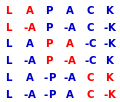LAPACK
 | |
| Initial release | 1992 |
|---|---|
| Stable release |
3.8.0
/ 12 November 2017 |
| Written in | Fortran 90 |
| Type | Software library |
| License | BSD-new |
| Website |
www |
LAPACK (Linear Algebra Package) is a standard software library for numerical linear algebra. It provides routines for solving systems of linear equations and linear least squares, eigenvalue problems, and singular value decomposition. It also includes routines to implement the associated matrix factorizations such as LU, QR, Cholesky and Schur decomposition. LAPACK was originally written in FORTRAN 77, but moved to Fortran 90 in version 3.2 (2008).[1] The routines handle both real and complex matrices in both single and double precision.
LAPACK was designed as the successor to the linear equations and linear least-squares routines of LINPACK and the eigenvalue routines of EISPACK. LINPACK, written in the 1970s and 1980s, was designed to run on the then-modern vector computers with shared memory. LAPACK, in contrast, was designed to effectively exploit the caches on modern cache-based architectures, and thus can run orders of magnitude faster than LINPACK on such machines, given a well-tuned BLAS implementation. LAPACK has also been extended to run on distributed memory systems in later packages such as ScaLAPACK and PLAPACK.[2]
LAPACK is licensed under a three-clause BSD style license, a permissive free software license with few restrictions.
Naming scheme
Subroutines in LAPACK have a naming convention which makes the identifiers very compact. This was necessary as the first Fortran standards only supported identifiers up to six characters long, so the names had to be shortened to fit into this limit.
A LAPACK subroutine name is in the form pmmaaa, where:
pis a one-letter code denoting the type of numerical constants used.S,Dstand for real floating point arithmetic respectively in single and double precision, whileCandZstand for complex arithmetic with respectively single and double precision. The newer version, LAPACK95, uses generic subroutines in order to overcome the need to explicitly specify the data type.mmis a two-letter code denoting the kind of matrix expected by the algorithm. The codes for the different kind of matrices are reported below; the actual data are stored in a different format depending on the specific kind; e.g., when the codeDIis given, the subroutine expects a vector of lengthncontaining the elements on the diagonal, while when the codeGEis given, the subroutine expects an n×n array containing the entries of the matrix.aaais a one- to three-letter code describing the actual algorithm implemented in the subroutine, e.g.SVdenotes a subroutine to solve linear system, whileRdenotes a rank-1 update.
For example, the subroutine to solve a linear system with a general (non-structured) matrix using real double-precision arithmetic is called DGESV.
Details on this scheme can be found in the Naming scheme section in LAPACK Users' Guide.
Use with other programming languages
Many programming environments today support the use of libraries with C binding. The LAPACK routines can be used like C functions if a few restrictions are observed.
Several alternative language bindings are also available:
See also
- List of numerical libraries
- Math Kernel Library (MKL)
- NAG Numerical Library
- SLATEC, a FORTRAN 77 library of mathematical and statistical routines
- QUADPACK, a FORTRAN 77 library for numerical integration
References
- ↑ "LAPACK 3.2 Release Notes". 16 November 2008.
- ↑ "PLAPACK: Parallel Linear Algebra Package". www.cs.utexas.edu. University of Texas at Austin. 12 June 2007. Retrieved 20 April 2017.
Further reading
- Anderson, E.; Bai, Z.; Bischof, C.; Blackford, S.; Demmel, J.; Dongarra, J.; Du Croz, J.; Greenbaum, A.; Hammarling, S.; McKenney, A.; Sorensen, D. (1999). LAPACK Users' Guide (Third ed.). Philadelphia, PA: Society for Industrial and Applied Mathematics. ISBN 0-89871-447-8.
External links
- Official website on Netlib.org
- LAPACK Users' Guide
- NAG Library LAPACK reference
- Sun Performance Library optimized LAPACK for Solaris OS on SPARC/x86/x64 and Linux
- How to use LAPACK with C
- LAPACK & BLAS precompiled binaries for Win32 platform
- LAPACK and BLAS for .NET